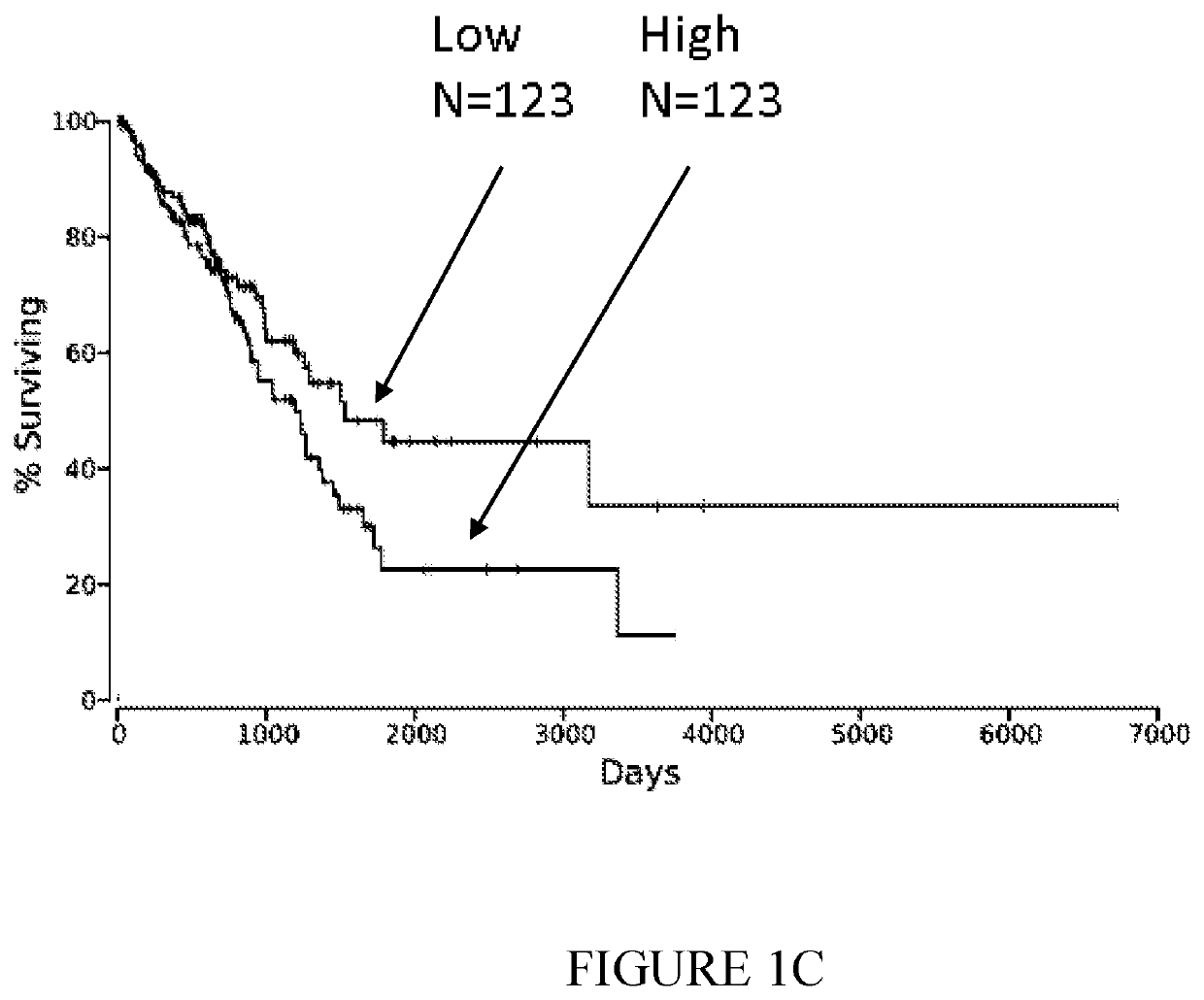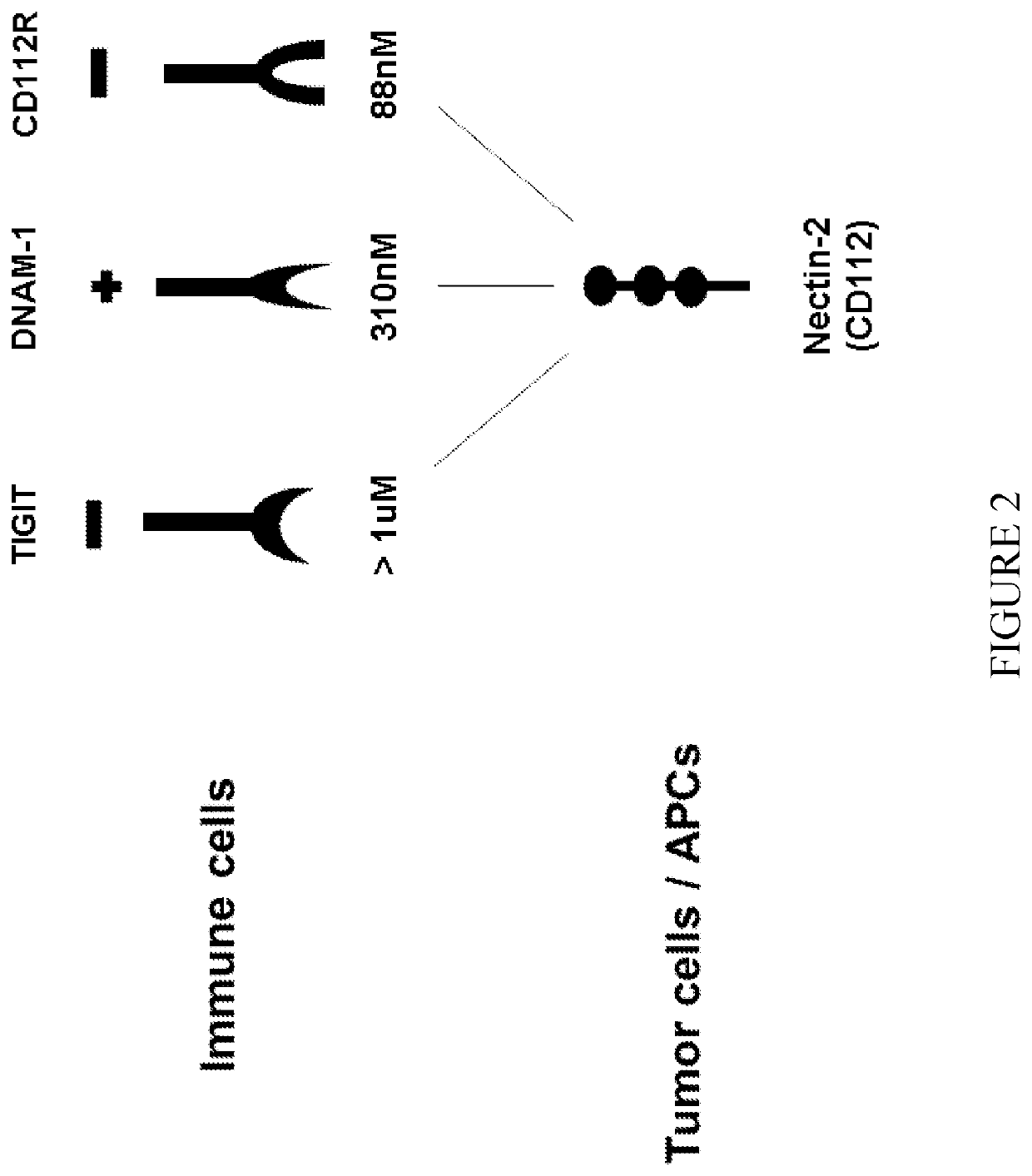Antibodies specific to human nectin-2
- Summary
- Abstract
- Description
- Claims
- Application Information
AI Technical Summary
Benefits of technology
Problems solved by technology
Method used
Image
Examples
example 1
ession of Nectin-2 mRNA Correlates with Poor Survival Probability of Various Cancer Patients
[0305]The correlation between Nectin-2 mRNA expression and survival probability was examined on data from TCGA site, and analyzed using oncolnc.org site, (https: / / doi.org / 10.7717 / peerj-cs.67). This correlation is indicated by the arrows in FIG. 1 for Low grade glioma (FIG. 1A; p=5.22E-5), Kidney Renal Clear Cell Carcinoma (FIG. 1B; p=0.00037) and lung adenocarcinoma (FIG. 1C; p=0.0319) patients.
example 2
Binds and Affect Immune Cells Through Specific Receptors
[0306]A schematic illustration (FIG. 2) of receptors expressed on immune cells and their respective affinities to Nectin-2 expressed by tumors or on antigen presenting cells (APCs). TIGIT relates to a co-inhibitory receptor on immune cells such as T and NK cells; DNAM-1 (also termed CD226) relates to an activating receptor on immune cells (e.g. T cells), and CD112R (also termed PVRIG) relates to a co-inhibitory receptor on lymphoid immune cells (e.g., T and NK cells); Nectin-2 (CD112) is an inhibitory ligand for immune cells, mainly via its binding to CD112R. According to the present invention, anti-Nectin-2 mAbs may block Nectin-2 interactions with its ligands CD112R and / or TIGIT and increase activation of immune cells.
example 3
of Binding and Blocking Characteristics of the Anti-Nectin-2 mAbs
[0307]Nectin-2 clones did not bind to parental 8866 cells (EBV positive Burkit lymphoma) which do not express Nectin-2. FIG. 3A illustrates binding of anti-Nectin-2 clones to MDA-MB-231 (breast adenocarcinoma) cells (black bars), which endogenously express Nectin-2 or to 8866-hNectin-2 cells (grey bars), which overexpress Nectin-2. All of the mAbs were used from hybridoma supernatants at 30 ul / well. For detection, Goat anti-mouse-647 Ab was used at 1:250 dilution. FIG. 3B shows the results of a FACS analysis of CD112R-Fc (extracellular domain of CD112R fused to human Fc region of IgG1) binding to 8866-hNectin2 cells. Of the generated antibodies, three clones (#9, 11 and 13) partially blocked these interactions, while one clone (#7) completely blocked them. FIG. 3C shows the results of a FACS analysis of DNAM-1-Fc binding to 8866-hNectin2 cells. Other than clone 15, none of the other clones (#7-13) blocked the binding o...
PUM
| Property | Measurement | Unit |
|---|---|---|
| Fraction | aaaaa | aaaaa |
| Fraction | aaaaa | aaaaa |
| Fraction | aaaaa | aaaaa |
Abstract
Description
Claims
Application Information
 Login to View More
Login to View More - R&D
- Intellectual Property
- Life Sciences
- Materials
- Tech Scout
- Unparalleled Data Quality
- Higher Quality Content
- 60% Fewer Hallucinations
Browse by: Latest US Patents, China's latest patents, Technical Efficacy Thesaurus, Application Domain, Technology Topic, Popular Technical Reports.
© 2025 PatSnap. All rights reserved.Legal|Privacy policy|Modern Slavery Act Transparency Statement|Sitemap|About US| Contact US: help@patsnap.com



